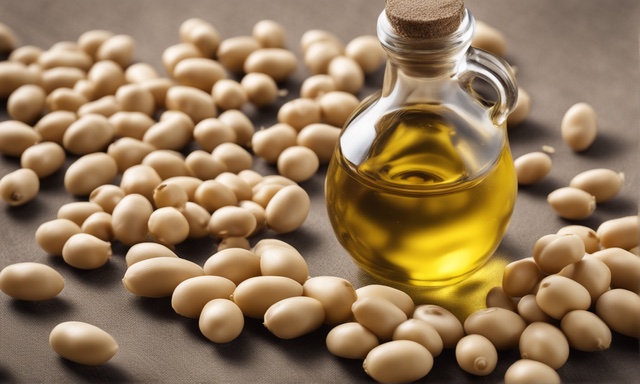Internet Asks: "High Oleic Soybean Oil"
High oleic soybean oil has notably carved its niche in both the culinary and industrial worlds, largely attributed to its unique profile of fatty acids, particularly the elevated levels of oleic acid. Diving into its characteristics, benefits, and diverse applications helps illuminate why high oleic soybean oil is gaining popularity across various sectors.
sponsored links

A Glimpse into Oleic Acid
Oleic acid, a monounsaturated omega-9 fatty acid, has been noted for stability benefits compared to polyunsaturated fatty acids. This stability grants oleic acid a higher resistance to oxidation, which translates to a longer shelf-life and better performance at high temperatures. It also offers potential health benefits, such as improving lipid profiles and providing anti-inflammatory effects. Traditional soybean oil has an oleic acid content of around 20%. In contrast, high oleic soybean oil boasts oleic acid levels upwards of 70%.
Nutritional Perspective
High oleic soybean oil brings forth various nutritional aspects:
- - Heart Health: Numerous studies suggest that oleic acid can positively influence heart health by helping to maintain cholesterol levels.
- - Antioxidant Rich: The oil contains vitamin E, an antioxidant that helps protect cells from damage and enhances skin health.
- - Neutral Flavor: With a neutral and subtle taste, it does not overpower the original flavor of dishes, making it suitable for various culinary creations.
Culinary Applications
High oleic soybean oil is revered in the culinary world due to several prominent features:
- - High Smoke Point: It boasts a high smoke point, making it suitable for a variety of cooking methods, including frying, sautéing, and baking, without breaking down into harmful compounds.
- - Stability: Its stability extends the shelf-life of products and prevents rancidity, maintaining the quality and nutritional value of the oil over time.
- - Versatility: Its neutral flavor allows it to be used in a myriad of dishes, from salads to baked goods, without altering the desired taste.
sponsored links
Industrial Applications
In the industrial domain, high oleic soybean oil finds utility in several areas:
- - Biofuels: It is utilized as a component in biodiesel production, contributing to creating cleaner-burning fuel.
- - Plastic Manufacturing: The oil is often used in producing plastics and resins, offering a biodegradable and renewable alternative to petroleum-based products.
- - Cosmetic Industry: Its stability and skin-health properties make it a valuable ingredient in various cosmetics and skin-care products.
Environmental and Sustainability Aspects
Given the expanding demand for plant-based oils in various sectors, high oleic soybean oil presents a sustainable option due to the soybean’s relatively lower resource requirements during cultivation. Moreover, with applications extending beyond the kitchen into realms like bioplastics and bio-lubricants, high oleic soybean oil emerges as an ingredient that can potentially aid in reducing reliance on petroleum-derived products.
Final Thoughts
High oleic soybean oil, with its elevated oleic acid content, does not only present a set of health and culinary advantages but also opens up a realm of possibilities in industrial applications. Its stability, neutrality in flavor, and potential health benefits make it a valuable resource, which is increasingly being recognized and utilized in various sectors.
Disclaimer: The information provided in this article is for general informational and educational purposes only and is not a substitute for professional advice. Always seek the advice of a qualified health provider with any questions you may have regarding dietary choices and any health concerns. For industrial applications, consult with a professional for safe and appropriate use.
sponsored links
References
1. Harvard T.H. Chan School of Public Health. Straight Talk About Soy. https://www.hsph.harvard.edu/nutritionsource/soy/
2. Foodcom. Soybean Oil – applications in the food and chemical industry. https://foodcom.pl/en/soybean-oil-applications-in-the-food-and-chemical-industry/#:~:text=Soybean%20Oil%20can%20be%20used,the%20automotive%20or%20aerospace%20industries.
3. Baer DJ, Henderson T, Gebauer SK. Consumption of High-Oleic Soybean Oil Improves Lipid and Lipoprotein Profile in Humans Compared to a Palm Oil Blend: A Randomized Controlled Trial. Lipids. 2021 May;56(3):313-325. doi: 10.1002/lipd.12298. Epub 2021 Feb 17. PMID: 33596340; PMCID: PMC8248317.
4. Harvard T.H. Chan School of Public Health. Legume of the month: Soybeans. https://www.health.harvard.edu/heart-health/legume-of-the-month-soybeans
5. Britannica. Soybean. https://www.britannica.com/plant/soybean
6. US Soy. High Oleic Soybean Oil. https://food.ussoy.org/food-industry-solutions/high-oleic-soybean-oil
7. AIDIC Servizi S.r.l. Biodiesel Production from Supercritical Ethanolysis of Soybean Oil. http://dx.doi.org/10.3303/CET1332139
8. US Soy. U.S.-Grown High Oleic Soybean Oil. https://ussec.org/wp-content/uploads/2020/07/2019-U.S.-Grown-High-Oleic-Soybean-Oil-Brochure-1.pdf
People are also reading...
Seed Soybean
Soybean Miso
Density of Soybean Oil
Soybean Oil Gluten-Free
Tofu and Diabetes
Are Carrots Acidic?
Is Truvia the Same as Stevia?
Whole30 What to Expect?
Are Mangoes Acidic?
Orange Juice pH?
Does Kahlua Have Caffeine?
Calories In a Grilled Cheese?
Ready to level-up?
Create meal plans 10x faster, follow up with your clients through our mobile app, and never struggle with meal planning or recipe management again.